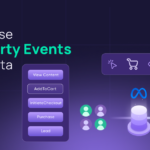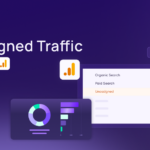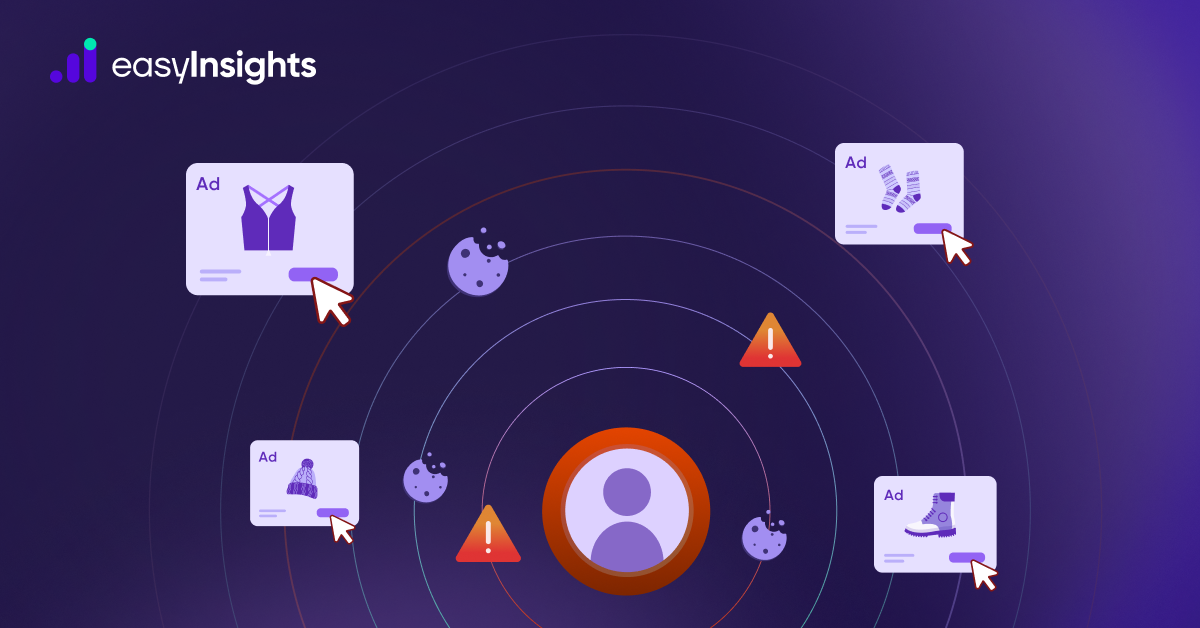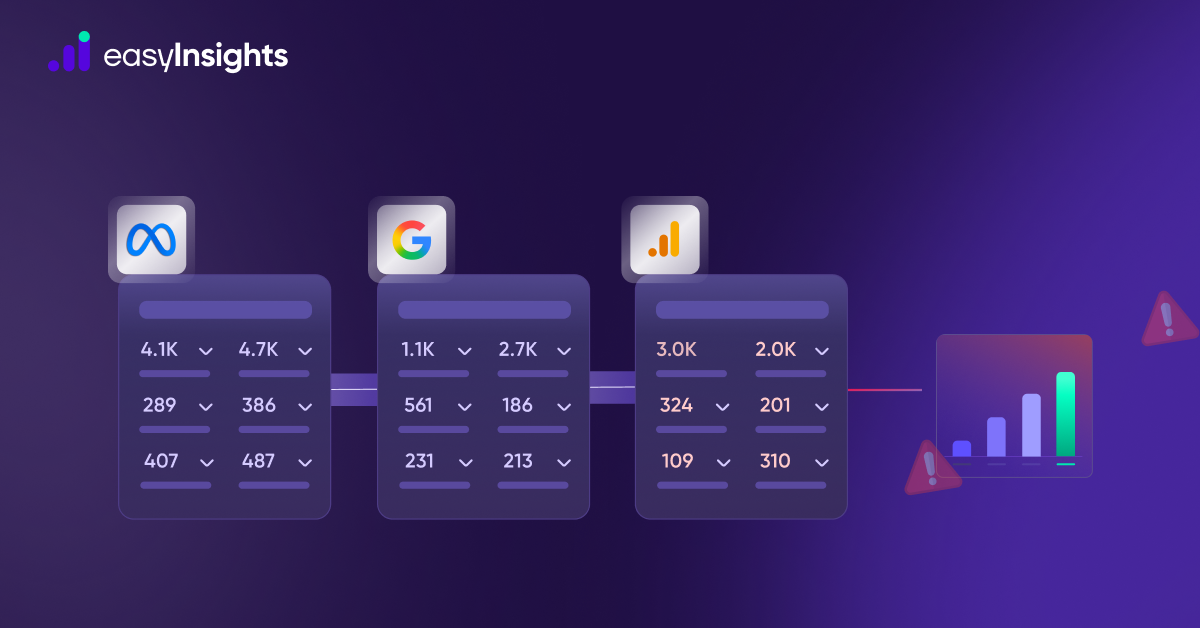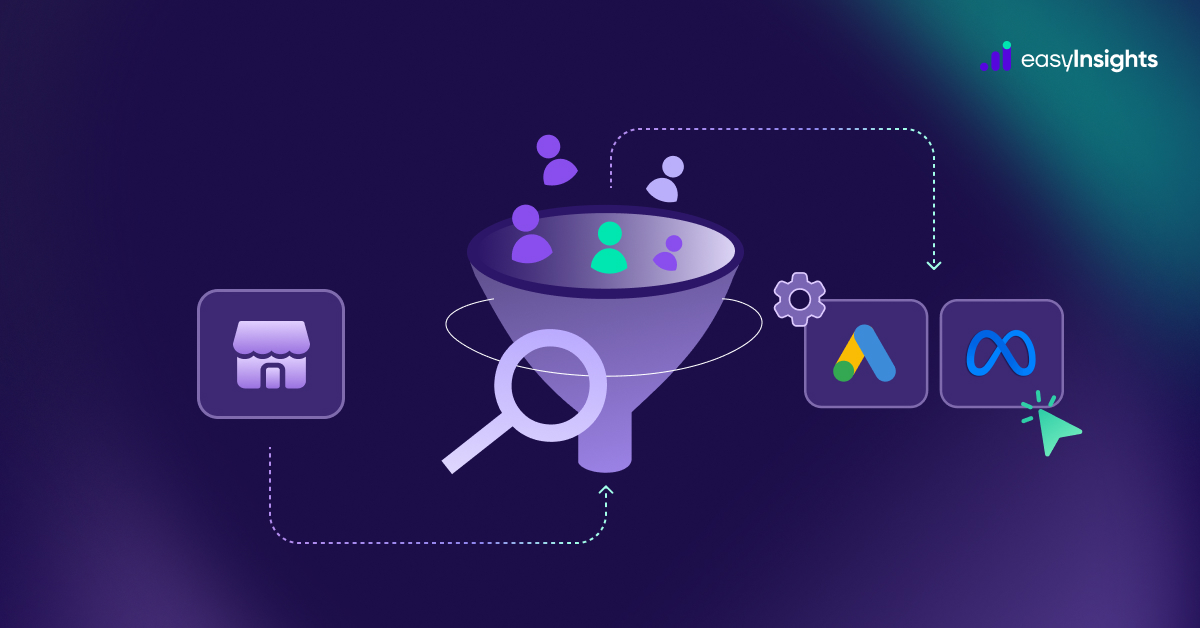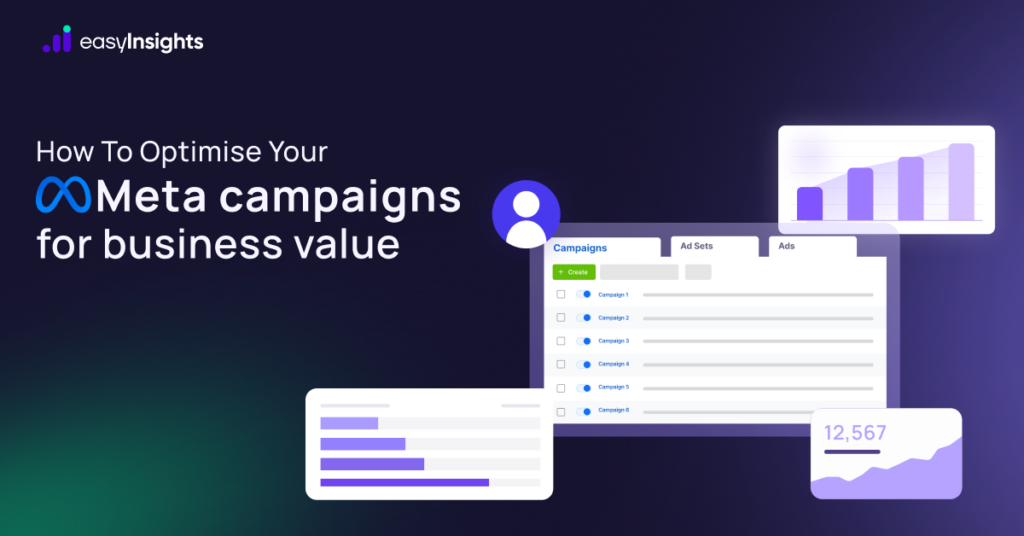
Marketers love to talk about ROI, but few truly optimise their Meta campaigns for long-term business value. Too often, campaigns are launched with a budget and left to run on autopilot, with marketers simply waiting for conversions. While Meta’s algorithm is powerful, it isn’t magic – it needs the right signals, strategy, and consistent refinement to deliver results that impact the bottom line.
Optimisation is more than pausing bad ads or changing bids. It’s about aligning campaigns with business outcomes like higher LTV, lower CAC, or sustainable revenue growth. Yet, many marketers still equate optimisation with cheaper clicks or quick wins, which don’t always translate into meaningful ROI.
In fact, over half of marketers admit they aren’t fully leveraging Meta’s advanced tools or first-party data integrations, often because they’re stuck in old practices or over-reliant on platform defaults. True optimisation in 2025 requires a shift, combining smarter audience strategies, clear value metrics, and budget allocation that prioritises business impact over vanity KPIs.
If your Meta campaigns are running but not truly moving the needle for your business, it’s time to rethink what optimisation means and take control of the results.
Jump ahead to:
Monitor and Benchmark Key Metrics Daily
Optimisation starts with awareness. Before you can improve performance, you need to deeply understand what’s happening – and why.
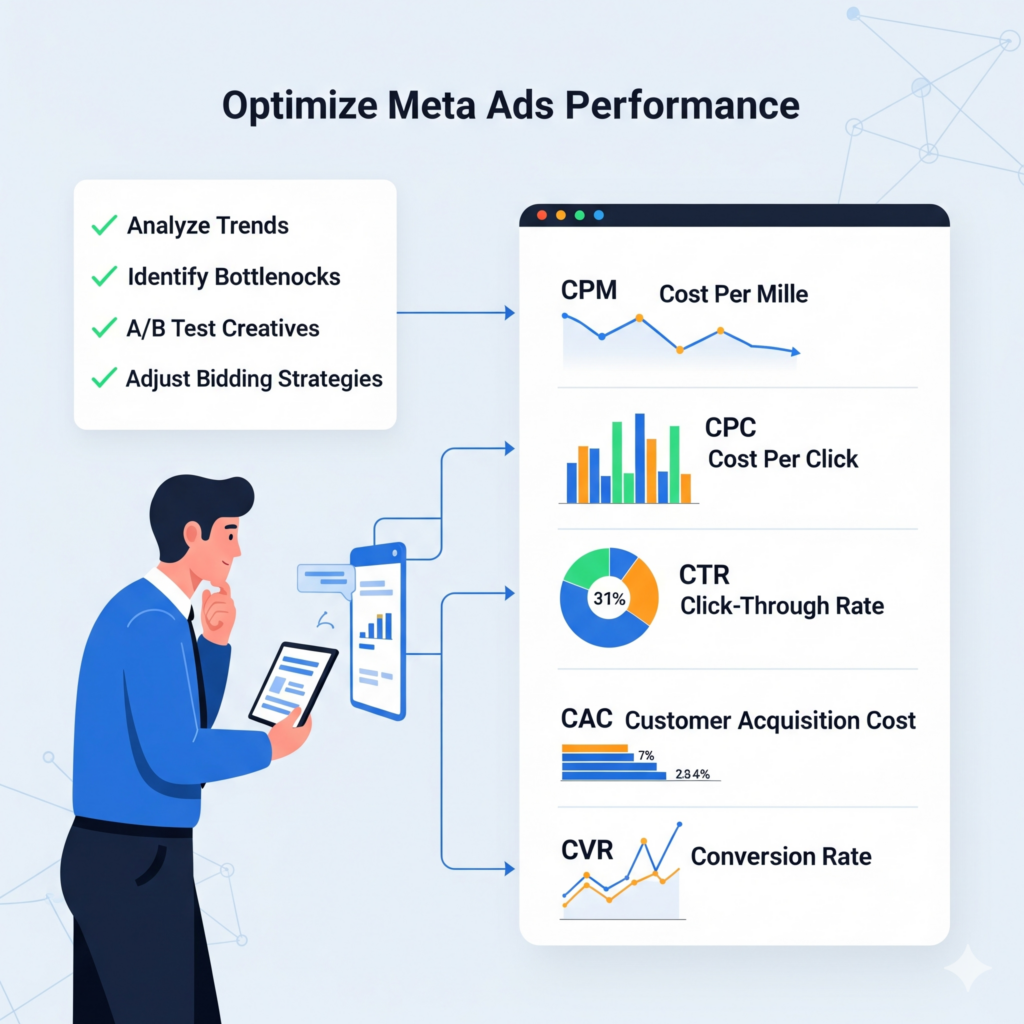
Spend 15 minutes every morning reviewing your Meta Ads performance. Don’t just look at ROAS in isolation. Compare CPM, CPC, CTR, CAC, and CVR against the previous day, week, or month.
- A drop in CPM might signal lower competition or relevance – good news if performance holds, but a red flag if conversion quality drops.
- If CPC suddenly dips and you’re getting more junk leads or low-quality traffic, investigate your conversion events. Something might be broken, especially post iOS17.
- Rising CAC? Consider using Target Cost per Result or Cost Cap bidding strategies to rein things in while keeping volume stable.
Keep a close eye on reach and frequency, especially for always-on or retargeting campaigns. High frequency with dropping engagement is a strong sign of ad fatigue – refresh your creatives immediately to avoid wasting budget.
Set up a reliable dashboard or report view that lets you track these metrics quickly. A clean, unified dashboard can save hours and help you spot anomalies before they become expensive problems.
Creative Isn’t Just Visual – It’s Strategic
Your ad copy and creative are the first filter between your brand and potential customers. While CTR (Click-Through Rate) is a useful early signal, it doesn’t guarantee quality results. A high CTR means your creative sparked interest – not that it drove meaningful conversions. That’s why your creative must align with your key conversion event and broader business goals.
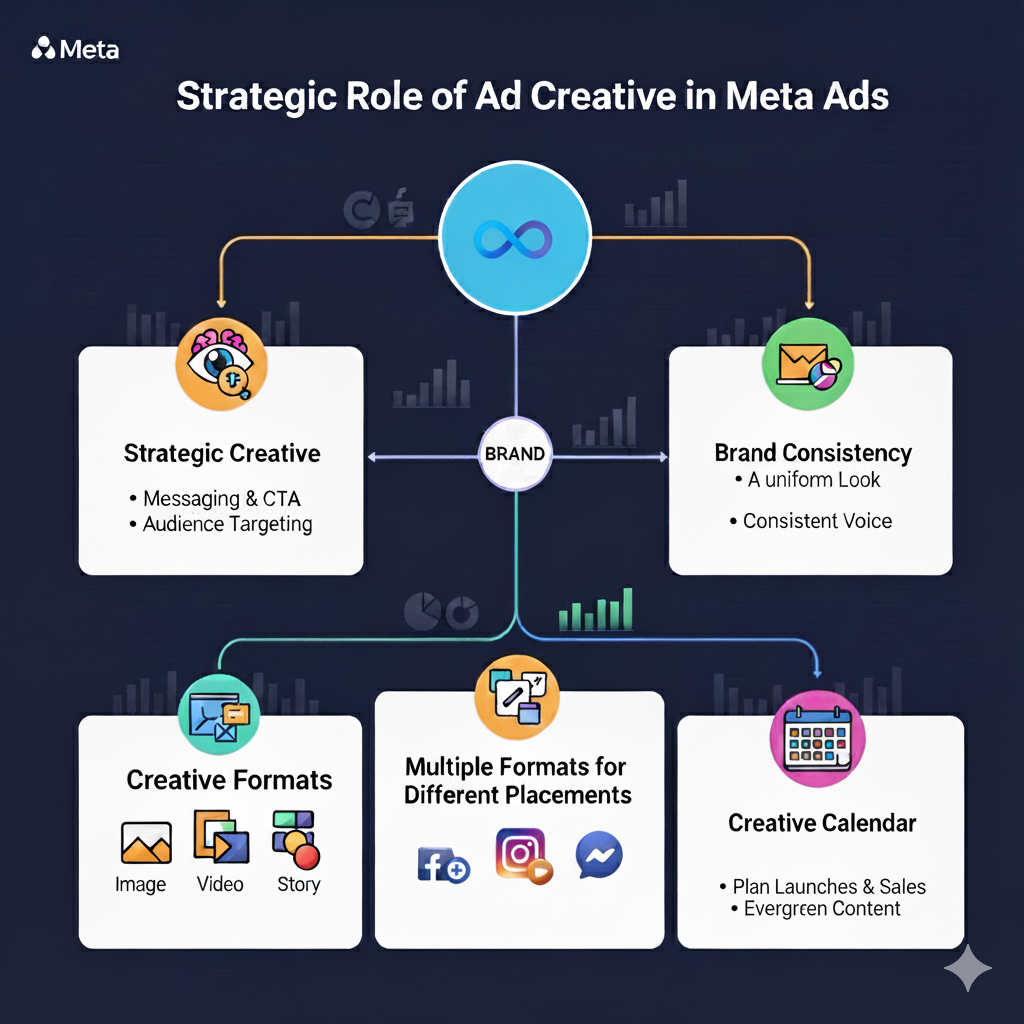
- Use your brand colors, tone, and messaging to build consistency and trust.
- Every ad should echo your core identity – whether that’s trust, innovation, affordability, or exclusivity.
- Always design multiple creative variations for each ad – different placements (feeds, reels, stories, right column) need different formats to look their best.
- Set up a monthly creative calendar with your team. Plan in advance for launches, seasonal moments, or trend-based hooks.
- Leave space for moment marketing – being timely with events like IPL, Raksha Bandhan, or flash sales.
Done right, a strong creative process reduces ad fatigue, improves conversion quality, and builds brand memory that compounds over time.
Set Up Campaigns with Funnel-Wise Targeting
A well-structured campaign setup does more than organise your ads – it aligns your targeting, creative, and conversion events with your business goals.
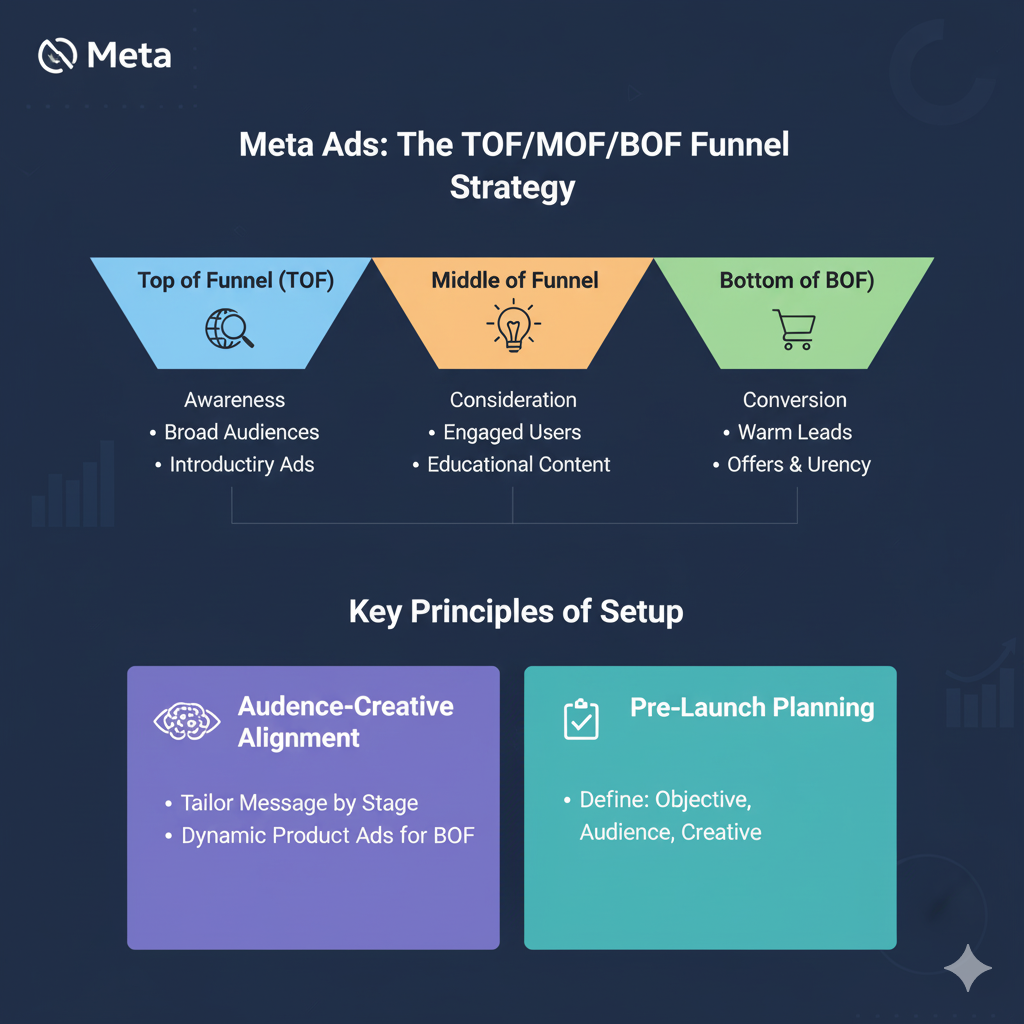
Before you launch anything, pre-plan your campaigns: define the funnel stage, audience, creative angle, and objective. Use a TOF (Top of Funnel), MOF (Middle of Funnel), BOF (Bottom of Funnel) structure to guide this. Each stage has a different audience mindset – your targeting and creatives should reflect that.
- TOF: Broad interest-based or lookalike audiences, creative that introduces your brand.
- MOF: Engaged users, website visitors, or video viewers – focus on education, trust, and value.
- BOF: Warm leads or cart abandoners – drive action with offers, urgency, or product-specific messaging.
Whenever possible, tailor creatives to each stage. Don’t show the same message to a cold user and a high-intent one. If you’re running D2C campaigns, catalog or dynamic product ads can work well at BOF to convert users already in-market.
Also, define your conversion event upfront – purchases, leads, or another key action. Don’t optimise for link clicks or add to cart unless that’s your actual goal. Meta’s algorithm performs better when your campaigns send clear, consistent intent signals.
In the early stages, focus more on TOF and MOF to build data and volume. BOF retargeting can scale only when the top of your funnel is healthy.
Targeting: Balance Precision and Algorithmic Scale
Even the best creative won’t work if it’s shown to the wrong audience. Targeting plays a huge role in campaign success – and in 2025, smart targeting means balancing manual precision with algorithmic learning.
- Use basic filters like age, gender, and location to define your core audience.
- Build custom audiences from your website visitors or app users.
- If you’re a lead gen brand or B2B company, upload customer lists (from your CRM or lead database) to retarget or create lookalikes.
- Don’t ignore broad targeting – it often gives Meta’s algorithm the freedom to find high-performing users, especially when paired with strong creatives and event signals.
- Use Interest & Behaviour (I&B) targeting to reach people based on previous engagement or purchase activity.
- Create Lookalike Audiences (LALs) from your best-performing custom audiences – purchasers, high-LTV users, or qualified leads.
- Use exclusions to keep your funnel clean – for example, exclude TOF and MOF audiences from your BOF campaigns to avoid overlap and message fatigue.
- Always test different targeting strategies using A/B tests – but make sure your test audiences don’t overlap, or it will skew your results and waste budget.
A well-rounded targeting approach helps Meta’s system optimise faster – and ensures your budget is spent on users who are more likely to convert.
Conversion Event: Define What Success Looks Like
Before launching any campaign, you need to define the conversion location and the desired event – because Meta’s optimisation engine will only work well if it knows what success looks like.
- First, decide where your conversion will happen – most commonly, this is your website (e.g., a lead form, purchase, or checkout event).
- Next, set your performance goal: whether it’s Maximize Conversions, Maximize Conversion Value, or Value Optimisation. You can even A/B test these goals to see what drives better ROI.
- Choose the right conversion event – it should reflect your most meaningful outcome, like “Purchase” or “Qualified Lead”, not intermediate actions like “Add to Cart” or “Page View”.
- Check the Event Match Quality (EMQ) of the event you’re optimising for. A higher EMQ score helps Meta better attribute, optimise, and scale your campaign.
- Use server-side tracking (like CAPI Gateway or direct API setups) to send high-quality events to Meta. This is especially important in a privacy-first world where browser-side signals are limited.
- Tools like EasyInsights help unify, enrich, and send clean, high-quality conversion events to Meta – boosting your EMQ and campaign performance without relying on pixel-only tracking.
In short, your conversion setup is not just a technical step – it’s a strategic one. The more clearly and accurately you define it, the more efficiently Meta can optimise your spend.
Smart Controls: Automate Where Needed, Stay In Control
Beyond setup and strategy, Meta offers powerful tools to manage your campaigns efficiently – but you need to use them wisely to avoid wasted spend or performance dips.
- Schedule your campaigns to go live or pause automatically – useful for time-sensitive offers or regional targeting.
- Use automated rules to trigger actions like pausing underperforming ad sets, increasing budgets for high performers, or stopping campaigns after hitting a spend threshold.
- Avoid sudden budget jumps – instead of doubling your budget overnight, increase it gradually (e.g., 15–20% per day) to maintain algorithm stability.
- Regularly run A/B tests for creative, copy, targeting, and optimisation goals – and be mindful of audience overlap, which can dilute results.
- Explore Meta’s AI enhancements (like text suggestions or auto-cropped creatives), but review them carefully – sometimes they misrepresent your brand or break design aesthetics.
- Test enhanced CTAs (like “Shop Now” with product preview) when available – they often improve click-through and conversion rates.
Small optimisations like these help ensure your campaigns are efficient, scalable, and aligned with long-term business impact – not just short-term performance blips.
Attribution, Learning & Landing Page Hygiene
Meta’s algorithm doesn’t operate in isolation – it relies heavily on your attribution setup, campaign consistency, and post-click experience to optimise effectively.
- Check your attribution setting – the standard is 7-day click and 1-day view, but make sure it’s consistent across campaigns to avoid reporting discrepancies.
- Always review performance breakdowns (by platform, age, placement, device) comparatively. Inconsistent settings across ad sets can make this data unreliable.
- Remember, Meta needs about 50 conversions per week to exit the learning phase. If your ad set hasn’t performed in 7 days, take quick action – revise creatives, targeting, or budget.
- Keep an eye on your destination pages – poor-performing or slow-loading landing pages hurt conversion rates, no matter how good your ads are.
- Ensure your ad message matches your landing page to reduce bounce and improve CVR. Misalignment here confuses users and weakens intent.
These backend details might seem small, but they make a big difference in how Meta interprets your campaigns- and how efficiently it spends your money.
Data Accuracy: The Foundation of Smarter Optimisation
Meta’s algorithm is only as good as the data you feed it. Inaccurate or incomplete data disrupts optimisation, inflates costs, and weakens performance over time.
- Prioritise data quality over quantity – clean, consistent data helps Meta optimise better, especially post iOS and signal loss.
- Use server-side tracking (like Conversions API) to send accurate first-party data directly to Meta. This boosts Event Match Quality (EMQ) and improves attribution.
Tools like EasyInsights.ai can automatically collect data from your website via pixel, CRM systems, and even offline sources – ensuring nothing gets missed ans send to ad platforms like Meta, Google, GA4 and many more.
- For lead gen brands, send lead stage updates (e.g., qualified, contacted, converted) back to Meta. This creates a smarter feedback loop for better targeting.
- For ecommerce, send Return-to-Origin (RTO) and cancellation data to avoid optimising for bad orders. This helps Meta focus on high-quality conversions.
- Use this clean data to create custom events and audience segments – like high-LTV users, repeat buyers, or qualified leads – and build lookalikes from them.
In short, better signals = better results. Investing in data quality today gives you a huge performance edge tomorrow.
Conclusion: Real Optimisation Starts with the Whole System
Optimising Meta campaigns in 2025 isn’t about quick fixes or surface-level tweaks. It’s about building a complete, interconnected system – where strategy, creative, targeting, bidding, attribution, automation, and data quality all work together to drive consistent, business-level impact.
Each layer matters. And when they’re aligned, you stop chasing vanity metrics – and start achieving real outcomes: lower CAC, higher LTV, stronger ROAS, and sustainable growth.
But the glue that holds all of this together is data. If your data is messy, incomplete, or poorly integrated, even the best strategies can fall flat.
That’s where EasyInsights becomes a game-changer. It brings together your first-party data from website pixels, CRMs, offline sources, and ad platforms into one clean, unified system. Whether you’re a D2C brand optimising purchases or a lead-gen business enriching lead stages, EasyInsights ensures your signals are sharp, your events are reliable, and your campaigns get the data they need to scale.
In 2025, real optimisation means owning your funnel, owning your signals – and most importantly, owning your data.
Book a demo Today with EasyInsights


